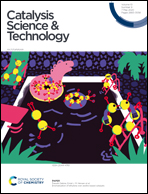Mechanism of nicotine degradation and adsorption by a nano-TiO2 engineered reduced graphene oxide composite in light variant conditions†
Abstract
Nicotine (C10H14N2), a hygroscopic molecule, has long been the focus of intensive research due to its rising number of detrimental impacts on human health, associated with the neuroactive alkaloid in tobacco. Water contamination in the form of nicotine substances is a serious issue, where clean water is one of the basic demands for living systems. This study reports exclusively on nicotine degradation and adsorption activity from its aqueous solution through an anatase-phase nano-TiO2 (20 ± 5 nm)-decorated reduced graphene oxide (rGO–TiO2) composite under ultraviolet (UV) and visible-light irradiation, respectively. In this study, XRD, XPS, FT-IR, Raman, UV-DRS, TEM, and BET analyses were applied for the characterization of the structural, optical, and surface morphological properties of rGO–TiO2. About 80% nicotine (1 mM) decomposition was found using 2 mg rGO–TiO2 after 90 min of UV light exposure, while 60% nicotine (1 mM) adsorption at the surface of the rGO–TiO2 (3 mg) was detected within 90 min of visible light illumination. A kinetic study on free radical generation (O2˙−, ˙OH, 1O2) demonstrated that the rGO–TiO2 nanosystem had a substantial rate (1.7-fold higher than TiO2) of ROS formation. Raman shifts showed the defects in the sp3-hybridized carbon of rGO due to the attachment of TiO2 NPs, thereby altering the electronic energy states of the rGO–TiO2 nanocomposite and leading to its superior adsorption via π–π and cation–π interactions. Nicotine degradation was perceived to follow the pseudo-first-order kinetic law, while the nicotine-adsorption activity due to chemisorption on the disordered rGO–TiO2 surface could be expressed via the Langmuir isotherm model. The application of the rGO–TiO2 nanohybrid is highly suggested to be beneficial on an industrial basis for nullifying the nicotine-prompted carcinogenic effects in aquatic systems.



 Please wait while we load your content...
Please wait while we load your content...